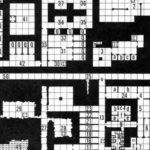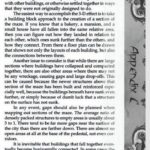Between Top Secret and James Bond 007, I’ve played countless hours of espionage-themed roleplaying games. As with any roleplaying adventure, particularly one focused on thievery or espionage, characters often dwell in the seedy underbelly of various metropoli, often literally delving into the cellars and sewers.
The classic Top Secret adventure Operation: Sprechenhaltestelle by Merle Rasmussen that was included in the boxed set was a strong formative influence. It turns out that Dyson of Dyson’s Dodecahedron was inspired by that map for one he drew, so I’m glad that I’m not alone in my love for making maps for adventures in the sewers and subways that lie just below our feet. One of the things I thought it captured best were all the different uses for various spaces and the organic feel where cellars connected to passages that led to entire underground areas, but not usually in a direct fashion.
Much like Seattle’s Underground or the University of Washington’s steam tunnels, underground areas evolve over time as buildings are covered over, new tunnels are dug, and previously existing underground areas are expanded. Take this idea to extremes and you might wind up with something like the city of Penance’s undercity from the Oathbound campaign setting, a sprawling three-dimensional maze with centuries of architecture layered atop each other. Done this way, it’s an inverse dungeon where the oldest parts are on the bottom with increasingly newer constructions closer to the surface. Contrariwise, a mine or a dungeon may be equally dangerous at the deepest levels, but it’s more by dint of defensibility or because the miners dug too deep and let loose something better left buried. As Saruman noted to Gandalf about the Mines of Moria, “The dwarves delved too greedily and too deep. You know what they awoke in, the darkness of Khazad-dum…Shadow and flame.” A city in layers more closely matches a setting like the Underdark, where the oldest and most settled parts are deep underground and the areas the characters explore are where those from below are pushing up to the surface. Either way, developing a history for a map allows for a more interesting space to explore than would otherwise be the case in a homogeneous setting where the challenge is arbitrarily dictated by a single element like the difficulty of the monsters that inhabit it.

